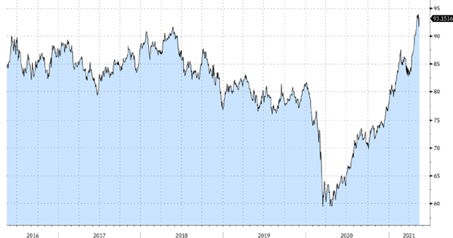
A sterling start to Spring
18 May 2021
Beware of the Calm (FX) Waters
1 June 2021INSIGHT • 25 May 2021
Commodity-based Currencies in Top 5 as Global Prices Surge

Ali Jaffari , Head of North American Capital Markets
Global commodity prices continue to surge higher as the one-way streak persists off the back of a global growth story and a stronger-than-anticipated economic recovery. The IMF expects the global economy to expand by 6% in 2021, the fastest since 1980. From metals to energy to agriculture markets, commodity price gains are hitting multi-year highs with no deterrent to the current trend. It is no surprise then, if you look at the top performing G10 currencies against the USD this year, that commodity-based currencies such as CAD, NZD and AUD all make the top five.
There has been a substantial growth in demand across the commodity complex, as major central banks continue to run with accommodative policy measures and vaccination rates climb, improving global mobility. China’s outsized recovery alone has bolstered its consumption to pre-pandemic levels, supporting the pickup in energy and metals markets. Australia in particular has been a beneficiary of China’s rebound as its core exports to the nation including iron ore, coal and wool provide a boost to its trade surplus. Across all major currency pairs, CAD has been the strongest performer against the dollar, gaining +5.5% so far this year. A wave of strong economic data, convergence with the US on the vaccine rollout, and the unwavering growth in commodity markets are all factors contributing to its strength.
The Bank of Canada’s commodity price index (based on 26 commodities produced in Canada and sold globally) is up a staggering ~30% YTD to reach a 7-year high. Although oil prices have always been a key driver for CAD, other base metals and raw materials have also contributed strongly to this recent loonie appreciation.
Unlike the Bank of Canada, which was one of the first major central banks to pull back on its pandemic-related QE initiatives, the Reserve Bank of Australia (RBA) and Reserve Bank of New Zealand (RBNZ) continue to maintain their accommodative stance, with the RBA not expected to raise rates until 2024. The ongoing dovishness from both central banks comes as a bit of a surprise given the strong rebound in economic recovery across both nations – unemployment rates continue to track lower with Australia expected to revert to pre pandemic levels in 2021, and New Zealand’s core inflation is on target while commodity export prices continue to rip higher.
Both AUD and NZD are up +1.3% and 0.8% vs the dollar this year, with strong commodity prices also providing a boost to the antipodean currencies. Local commodity indices have witnessed significant increases, with the Australian index largely driven by bulk commodities (iron ore, coal), whereas New Zealand’s index is mainly driven by its largest export, dairy (up 41.3% YoY).
Similarly, the broader Bloomberg Commodity Index, of which over a quarter of the make up is metals (the remainder being energy and agriculture) is up ~24% since the onset of the pandemic (see Chart 1). Despite this unprecedented rise, it is possible that the full extent of price increases is yet to be baked into the currency strength.
Chart 1: Bloomberg Commodity Index

Source: Bloomberg
From the three currencies, AUD currently bears the strongest correlation with the Bloomberg Commodity Index at 39%., followed closely by the NZD and then CAD. It’s worth noting that these correlations were much higher (averaging ~60%) earlier in the quarter and remain quite reactive to commodity headlines. However, it’s not uncommon to see correlations with commodity-based currencies lag at times, especially when other market factors are at play. Just look at CAD and crude oil prices for example. In fact, we have seen a steady decline in recent weeks as CAD seems unphased by the leg lower in crude oil prices given that other core prices remain buoyant across agriculture, forestry and metals.
With the global recovery advancing, central banks maintaining expansionary policy measures and a continued rise in commodity prices, commodity-based currencies seem well positioned to prosper. As other market factors subside and correlations with core commodity prices move back to their average range, increased export prices will weigh positively on trade balance which in turn could directly influence currency strength.
With increased global mobility however, it is also important to factor in price elasticity on certain goods. Taking iron ore as an example, China is currently reliant on Australia’s production, however, it is looking at measures to moderate the market through either diversification (60% of imports come from Australia) or investing in / exploring alternatives for its steel production. Lastly, as a stronger currency can weigh on local exporters, central bank expectations will play a key part in sizing the commodity growth impact on the home currency.
Be the first to know
Subscribe to our newsletter to receive exclusive Validus Insights and industry updates.



